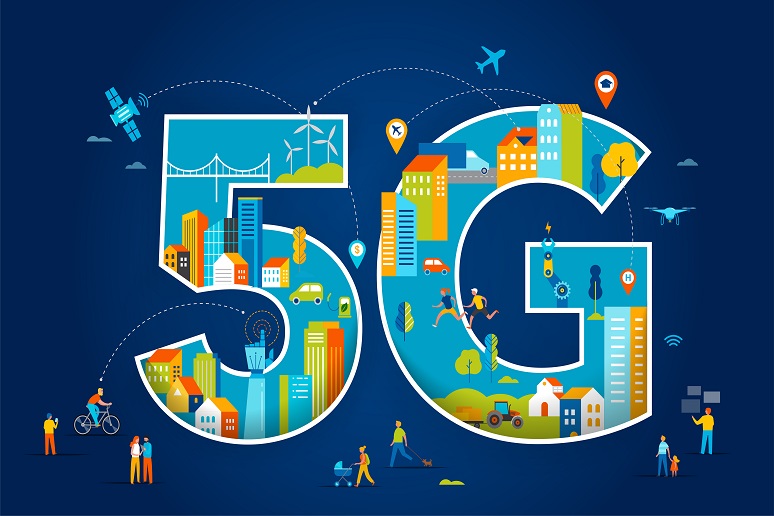They say honeymooning in Niagara Falls sets you up for the second biggest disappointment in your newly married life. In technology, the buildup of — often unrealistic — expectations doesn’t always meet reality. How many times have we bought the hype only to be underwhelmed by what has eventually been delivered? But, once in a while, the hype meets the expectation. For me, I immediately think of the statue of David, displayed in all its glory, at the Galleria dell'Accademia in Florence, Italy. And in technology, I am as impressed with the
potential of 5G.
While the promises of 5G are endless — autonomous cars, smart cities, even a connected universe — one place we’ll feel direct, tangible benefits sooner than the rest will be the “new normal” of work. From accessibility and culture to security and productivity, 5G will redefine the workplace sooner than we think.
The new network has landed during an auspicious time, when more people need to be connected to their workplaces, and many of them from new or different locations. Remote work has largely removed geographic barriers, workforces are becoming even more distributed, and expectations around productivity are shifting. Through this new hybrid lens, how will the availability of 5G shape the future of work?
Creating Greater Access for True “Work from Anywhere”
Today, remote work conjures images of employees at a home office, kitchen table, or anywhere they can clear space. 5G is making it possible to work from virtually anywhere, on any device — completely changing what the remote office looks like. Once deployed at scale, we won’t be tied to our Wi-Fi routers. Widespread 5G network technology offers the freedom to log in and view documents on a tablet during halftime of the kids’ soccer game, join a video call while taking a walk, start an impromptu digital whiteboard session the moment inspiration hits, all with fast, reliable connections that reduce latency challenges.
To make this real remote work environment a reality, businesses will need to continue their transition to cloud communications and embrace what 5G offers. Running on 5G, solutions that enable cohesive communications — calling, messaging, and conferencing — on high-bandwidth networks will future-proof employee collaboration.
Removing Limitations that Exist with Co-working and Living
One unique aspect of hybrid work is the seamless integration into life itself. I’ve enjoyed more dinners at home by saving seven to 10 hours each week commuting; I’ve been able to work from Tahoe while my 11-year-old daughter skied with her team and work adapted to my life, not the other way around. Work, after all, finally became what we do, not where we do it.
But that integration also puts a strain on bandwidth. The minute someone decides to stream a movie or upload a video, your work connection risks stalling. Today, this results in the dreaded conference call lag, getting booted off a system completely, or documents not loading when you need them. It makes the promise of working and living in one digital ecosystem a challenge.
5G, nearly instantly, solves these challenges. With faster connectivity and greater bandwidth, there is virtually nothing that could slow down remote work or living. What’s more, it increases the scope of work that can be done remotely without risk of slow down. Programming, customer service, and more all become easier and more effective to execute remotely with 5G.
Unlocking the Potential of Digital Tools
Today, workforces can leverage numerous digital tools to get the job done. From AI-powered chatbots to blockchain programs for supply chain management, the acceleration of digital transformation is helping teams put data and insight to work in new ways.
But these exciting digital features can also be a drain on bandwidth, or would just perform better with faster or more reliable connectivity. 5G will truly unlock the potential of these tools, allowing them to run faster, more frequently and with greater data — from virtually any location. The ability to rely on data as part of the day-to-day work experience, from research and merchandising to software development and customer experience, will make workers more informed, while redefining what productivity looks like and where it takes place.
While 5G holds the potential to impact virtually every part of our connected lives, the hybrid workplace is the first place we will feel its possibilities. For workers, this means everything from less friction day to day to greater accessibility for everyone to partake in the new normal of work.
The next step? Organizations need to ensure their communication systems are future-proof and ready for hybrid environments — complete with cloud-based solutions that ensure work can take place anywhere, at times best suited for teams. With less friction and wherever-you-are connection, employees can focus on what they need to get the job done: communication and collaboration.
Embrace 5G and be ready to be wowed, just like Michelangelo planned it.










